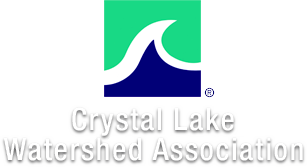Invasive Species

One of the CLWA’s highest priorities is preventing the spread of aquatic invasives into the Crystal Lake watershed environment. Since these nuisances are commonly introduced into a new lake by hitchhiking on watercraft that have picked them up elsewhere in infested waters, the CLWA has promoted boat washing on Crystal Lake.
CLWA has also focused on regular monitoring of the watershed to identify potential threats at an early stage, followed by rapid action to control or eliminate the intrusive plant or animal before it becomes widespread. In the summer of 2008, as part of the Cooperative Lakes Monitoring Program (CLMP) the CLWA sampled, identified, and mapped aquatic plant species for comparison with previous studies. It launched a new comprehensive aquatic plant identification and mapping survey in the summer of 2016, again under the auspices of the CLMP. This survey was completed in the summer of 2018, with the assistance of aerial drone observation.
Eurasian watermilfoil was the only invasive aquatic nuisance plant detected during the survey. It is well established and extensive at the east end of the lake, in the area of the Beulah public boat launch. Smaller patches occur at the eastern parts of the north and south shores, again in the vicinity of public boat launches (for example, at the Mollineaux Road DNR launch and the Lobb road end). The CLWA is now developing a treatment and control plan to prevent this problem from becoming more severe. For the latest news about treatment plans, CLICK HERE.
Members of the public can help control the introduction and spread of invasive species in Crystal – by washing their boats and by watching for and reporting the appearance of any unfamiliar plants or animals in the water or on the shoreland. Below is a list of species that currently pose a particular threat to Crystal Lake, along with links to more information and how you can report any observations.
Sightings may also be reported to: info@crystallakewatershed.org
The following invasive plants and fish already exist in the Crystal Lake Watershed. Occurrences should be reported so that prompt control measures can be taken:
Phragmites Australis (Common Reed)
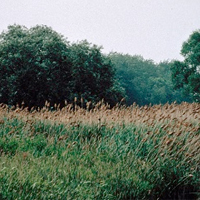
One of northwest Michigan’s “Top 20” invasives. A warm-season perennial grass with a rigid hollow stem and leaves that are flat, smooth, and green to grayish-green. The flowers grow as dense branched clusters on the end of each stem that are open and feathery at maturity. The plant ranges in height from 6-13 feet. Its dense spread quickly takes over wetlands.
Eurasian Watermilfoil (Myriophyllum spicatum)

An aquatic plant with stems that are whitish-pink to reddish-brown, leaves that are greyish-green with finely divided pairs of leaflets that are 1/2 – 2 inches long that give the plant a feathery appearance. The leaves are arranged in whorls of 3-6. Yellow or reddish flowers with 4 parts on a projected spike sitting 2-4 inches above the water.
Quagga Mussel (Dreissena rostriformis bugensis)
 A close relative of the Zebra mussel which already infests Crystal Lake, but more damaging, Quagga mussels were first found in Crystal Lake in 2024. Like its cousin, it consumes native phytoplankton and clogs lakeshore recreational equipment. More rounded shell and less prominent dark rings than the Quagga. Can grow to 2 inches in length.
A close relative of the Zebra mussel which already infests Crystal Lake, but more damaging, Quagga mussels were first found in Crystal Lake in 2024. Like its cousin, it consumes native phytoplankton and clogs lakeshore recreational equipment. More rounded shell and less prominent dark rings than the Quagga. Can grow to 2 inches in length.
New England Mudsnail (Potamopyrgus antipodarum)
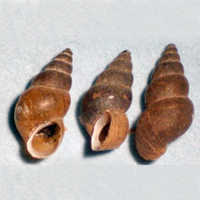
Small dark snails that reproduce rapidly to high densities in many habitats. Their small size makes them difficult to detect when attached to fishing gear or watercraft. They are abundant in the Platte River.
Red Swamp Crayfish (Procambarus clarkii)

Dark red color with bright red raised spots: look like small lobsters. Length 2.2 – 4.7 inches. Compete aggressively with native crayfish for food and habitat. Introduced by live bait dumping, aquarium trade.
Hydrilla (Hydrilla verticillata)

Submerged aquatic plant; green leaves whorled in groups of 4-8. Very slender stems can grow up to 30 feet long. White 3-petaled flowers. Forms dense mats that shade out native vegetation and interferes with recreational activities.
Starry Stonewort (Nitellopsis obtusa)
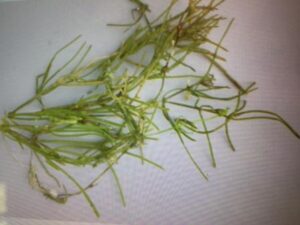
Submerged whorls of 4-6 leaves with blunt tips; can reach up to 33 inches. Forms dense mats that significantly reduce the diversity of other aquatic plants. Mats impede movement of fish, water flow, and recreational activities.
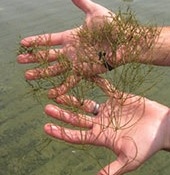
 Protecting Crystal Lake Now for Generations to Come.
Protecting Crystal Lake Now for Generations to Come.
P.O. Box 89 • Beulah, MI 49617
info@crystallakewatershed.org
231.882.4001 Tel
The Crystal Lake Watershed Association (CLWA), is a non-profit (501c3) organization.
Photography: Jay Burt and Rick Cosaro
Site by: Rick Cosaro
